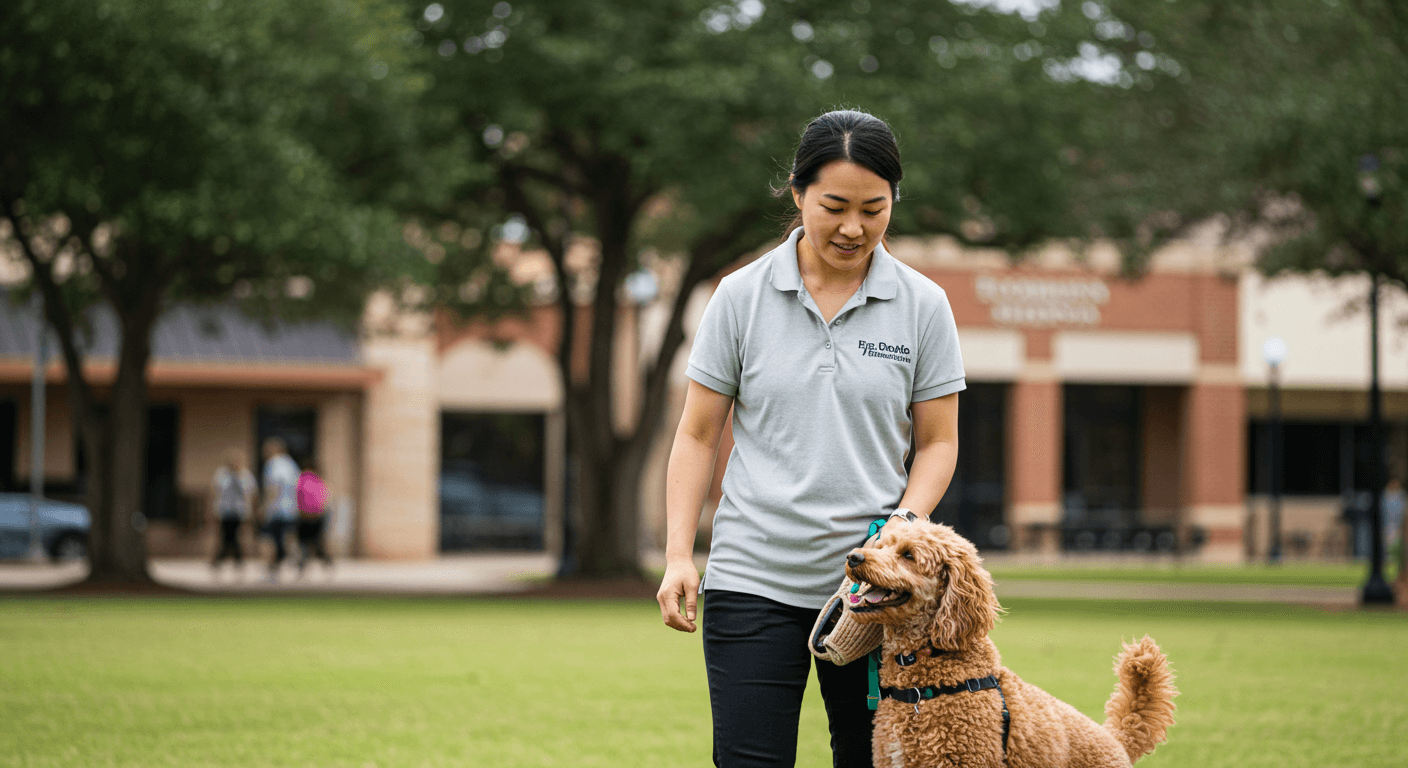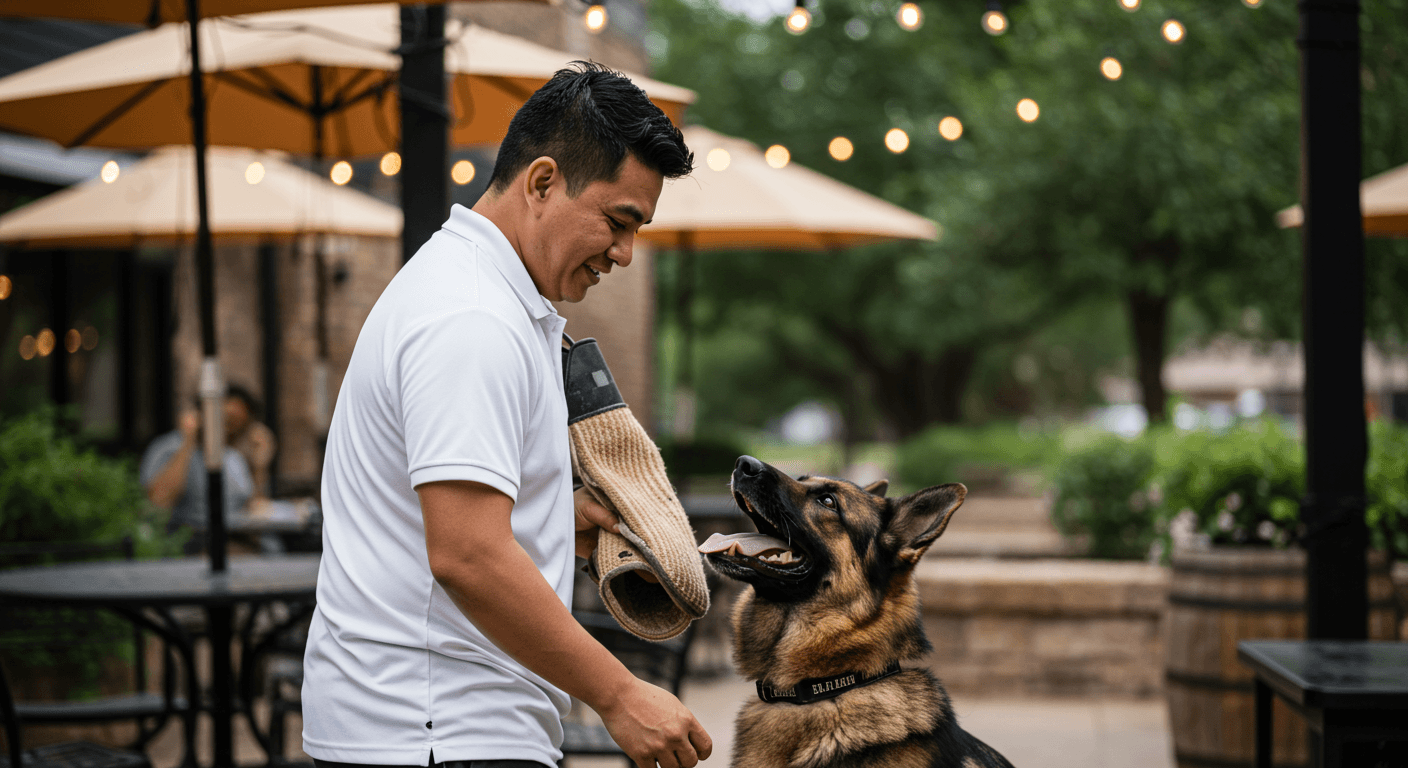Your Complete Guide to Choosing a Dog Trainer in Tomball TX and Surrounding Areas
Living with a dog in Tomball means navigating bustling spots like Main Street during festivals, walking the trails at Burroughs Park, and making sure your pup behaves during errands around the FM 2920 corridor. Your dog needs solid manners to handle all of this, from calm greetings at local coffee shop patios to staying focused when kids on bikes zip past on neighborhood sidewalks.
Since Tomball sits in Harris County, most local rules follow county and state guidelines. When you find a professional dog trainer who understands these local details, you’ll get better results both at home and out in your community.
How to Choose the Right Trainer
Start by looking for someone who uses positive reinforcement training and can set realistic goals for your Tomball lifestyle. This means your dog should learn to walk calmly through busy parking lots, stay polite near the Saturday farmers market crowds, and handle vet visits without drama.
Credentials give you a quick way to compare trainers’ experience levels. Common dog trainer certifications include KPA-CTP, CPDT-KA, or IAABC-CDBC for behavior problems. If your dog has serious aggression or reactivity issues, look for someone with CBCC-KA or a science-based program like CTC.
In-home dog training works great for puppy training, door manners, and neighborhood leash skills. Group classes make sense once your dog can focus around other dogs, especially before you try busy spots like the Old Town Spring area just down the road.
Common Dog Training Methods Explained

Reward-based methods build the trust you want while creating lasting behavior changes. They also help you follow Harris County’s rules about keeping dogs under control in public.
Basic obedience covers sit, down, stay, place, recall, and leash training so your dog can handle walks, restaurant patios, and park visits without pulling or jumping on people.
Puppy classes focus on socialization, potty training, bite control, crate comfort, and early leash work. Starting with short, positive training sessions prevents bad habits from forming in the first place.
Behavior modification addresses fear, reactivity, resource guarding, or separation anxiety through careful desensitization and counterconditioning. For serious cases, ask if your trainer works with local veterinarians.
Private lessons and in-home training let you customize everything around your daily routines, while day training can speed up results when you’re short on time.
Dog training classes help your dog practice good manners around other dogs and people. The best classes give dogs plenty of space, screen participants carefully, and teach calm behavior rather than just excitement.
Specialized training like therapy dog training or service dog training requires extra structure, public-access skills, and a very clear step-by-step training program.
Stay away from trainers who use fear, intimidation, or pain to get results. Humane methods are safer for everyone, easier to maintain long-term, and much better for keeping peace with your neighbors.
Average Cost of Dog Training in Tomball TX and Surrounding Areas (Updated for 2025)
Prices around Tomball and Harris County depend on the trainer’s experience, how long training sessions last, and where the training happens. Here’s what most local pet owners are paying in 2025.
| Service Type | Average Cost (Tomball/Harris County) |
|---|---|
| Puppy classes (4-6 weeks) | $140-$260 total |
| Group obedience training classes (4-6 weeks) | $150-$280 total |
| Private lessons (60-90 min) | $100-$180 per session |
| In-home coaching packages (4-6 visits) | $400-$850 total |
| Day training (trainer works your dog + handoff) | $425-$900 per week |
| Behavior consult for reactivity/anxiety (initial) | $140-$240 |
| Board and train (2-4 weeks) | $1,900-$4,200 total |
You’ll probably pay extra travel fees for longer distances within Harris County, and expect higher rates for complex behavior work.
Make sure you understand what’s included in dog training services, how the trainer tracks progress, and whether they offer a free consultation before you sign up.
Questions to Ask a Potential Dog Trainer
- What training methods do you use, and how do you keep sessions positive and low-stress?
- What credentials do you have, like KPA-CTP or CPDT-KA? Do you keep up with continuing education such as CPDT-KSA?
- How will you customize the training plan for my dog’s specific needs and our Tomball lifestyle?
- Do you offer in-home visits, group classes, or day training, and which approach fits my goals best?
- How will we measure my dog’s progress and know when to add more distractions?
- What are the total costs, including any travel fees, and what’s your cancellation policy?
- Do you carry liability insurance, and can you show me proof?
- For behavior problems, will you work with my veterinarian if needed?
- What should I practice between our sessions to help my dog keep improving?
Local Tomball Rules and Considerations
Tomball enforces leash laws and nuisance rules to keep parks and neighborhoods safe for everyone. Harris County follows Texas public health requirements too.
Leashes are required in all public spaces except inside designated dog parks. Keep a standard 6-foot leash with you for city parks, downtown walks, and community events.
Texas law requires current rabies vaccination for all dogs. You can get these through county clinics or your regular vet, and find more details through the Harris County Public Health website.
Excessive barking can be considered a nuisance, so work with your trainer on alert barking and separation anxiety before neighbors start complaining. If your trainer wants to use city parks for commercial sessions, they may need permits and proof of insurance.
Texas doesn’t require special licenses for dog trainers, but professional dog trainers should follow normal business regulations. If a business boards dogs for payment, the state’s Animal Health Commission may oversee certain facility requirements.
Harris County Animal Shelter has information and resources regarding lost pets, microchips, and other county resources.
Local Tomball Resources for Dog Owners
These spots give you great places to practice polite manners, work on recalls, and provide safe enrichment for your dog. Always follow the posted rules and etiquette guidelines.
- Burroughs Park offers over 320 acres with trails perfect for leash training and building focus around wildlife, joggers, and families. The park is a great place to work on loose-leash walking before tackling busier locations.
- Tomball Dog Park on Commerce Street provides a fenced off-leash area where you can practice recalls and calm greetings during quieter times of day.
- Pundt Park in Spring (just south of Tomball) welcomes leashed dogs on trails and picnic areas, giving you excellent opportunities to help your dog learn impulse control around new smells and distractions.

FAQs
How much does in-home dog training cost?
Most Tomball trainers charge $100-$180 per in-home visit, with discounts available when you buy packages. Behavior problems typically start at the higher end of that range.
Is in-home dog training worth it?
Absolutely, because you’re working on problems exactly where they happen. Your trainer can fix door manners, jumping on guests, counter-surfing, and yard reactivity right at home, then step outside to practice leash skills on your actual neighborhood sidewalks.
Can you pay someone to house train your dog?
Yes, many trainers offer puppy programs that include potty training, crate routines, and daily schedules. Day training can speed up the process while teaching you how to maintain the progress.
What is the 3-3-3 rule for dog training?
This is a helpful timeline for new or adopted dogs: expect about 3 days for your dog to decompress, 3 weeks to learn your routines, and 3 months to feel completely settled. Good training for dogs works with this natural adjustment period.
How long will it take to reach my training goals?
Most puppies and friendly adult dogs show solid progress within 4-8 weeks if you practice daily. Fear, reactivity, or aggression typically requires several months of careful behavior modification with gradual increases in difficulty.
What should I bring to group classes?
Pack a flat collar or harness, a 6-foot leash, high-value treats, water, and current vaccination records if your trainer requests them. Leave retractable leashes at home for safety reasons.
What’s the leash law in Tomball?
Dogs must be leashed and under control in all public areas, except inside designated off-leash dog parks. Keep that 6-foot leash handy for downtown walks, city parks, and community events.
Do I need a dog license in Tomball or Harris County?
Harris County doesn’t require general pet licenses, but keep your dog’s rabies vaccination current. For county services and microchip information, visit the Harris County Animal Shelter website.
What shots does my dog need in Harris County or Texas?
Rabies vaccination is required throughout the state. Your veterinarian may also recommend distemper-parvo and bordetella based on your dog’s lifestyle. Check state guidelines through the Texas Department of State Health Services.
Are dog trainers required to be licensed in Tomball or Harris County or Texas?
No special trainer licenses exist in Texas. Expert dog trainers follow normal business regulations, but if they offer board and train services, their facility may need to meet certain standards under state animal health regulations.
Where can I practice off-leash recall?
Use fenced dog parks in Tomball or nearby Spring and The Woodlands to keep things safe and legal. Try visiting during quieter hours when you’re starting out.
Which dog parks allow training around Tomball?
Tomball Dog Park on Commerce Street allows off-leash play within its fenced area. In nearby Spring, Pundt Park has designated dog areas. Both are solid options for practice sessions and building a well-behaved dog.
What beaches or trails allow dogs for training?
While there aren’t beaches in Tomball, leashed dogs are welcome on trails at Burroughs Park and Pundt Park. These trails are perfect for teaching calm focus around joggers, cyclists, families, and wildlife. For a longer trip, Galveston beaches allow leashed dogs on most stretches year-round.
How do I know if my dog needs aggressive dog training?
If your dog lunges, barks, growls, or snaps at people or other dogs, that’s reactivity or aggression that needs immediate attention. Look for a certified dog trainer with specific behavior modification credentials rather than standard obedience training. A free evaluation can help you understand what your dog needs.
What’s the difference between dog obedience training and behavior modification?
Dog obedience training teaches skills like sit, stay, and loose-leash walking. Behavior modification addresses emotional responses like fear, anxiety, or aggression through careful conditioning. Many dogs need both to become confident, well-mannered companions.
The right combination of thoughtful planning, humane methods, and consistent practice around Tomball’s parks and neighborhoods will help your dog become a confident, top dog companion. If credentials matter to you, don’t hesitate to ask about dog trainer certifications and how your trainer stays current with new techniques.